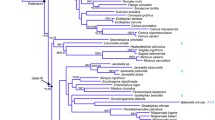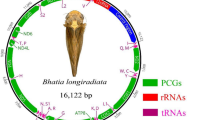Summary
Increasing data onDrosophila alcohol dehydrogenase (ADH) sequences have made it possible to calculate the rate of amino acid replacement per year, which is 1.7×10−9. This value makes this protein suitable for reconstructing phylogenetic relationships within the genus for those species for which no molecular data are available such asScaptodrosophila. The amino acid sequence ofDrosophila lebanonensis is compared to all of the already knownDrosophila ADHs, stressing the unique characteristic features of this protein such as the conservation of an initiating methionine at the N-terminus, the unique replacement of a glycine by an alanine at a very conserved position in the NAD domain of all dehydrogenases, the lack of a slowmigrating peptide, and the total conservation of the maximally hydrophilic peptide. The functional significance of these features is discussed.
Although the percent amino acid identity of the ADH molecule inDrosophila decreases as the number of sequences compared increases, the conservation of residue type in terms of size and hydrophobocity for the ADH molecule is shown to be very high throughout the genusDrosophila. The distance matrix and parsimony methods used to establish the phylogenetic relationships ofD. lebanonensis show that the three subgenera,Scaptodrosophila, Drosophila, andSophophora separated at approximately the same time.
Similar content being viewed by others
References
Ashburner M, Carson HL (1983) A checklist of maps of polytene chromosomes of drosophilids. DIS 59:148–151
Ashburner M, Bodmer M, Lemeunier F (1984) On the evolutionary relationships ofDrosophila melanogaster. Dev Genet 4:295–312
Benyajati C, Place AR, Powers DA, Sofer W (1981) Alcohol dehydrogenase gene ofDrosophila melanogaster. Relationship of intervening sequences to functional domains in the protein. Proc Natl Acad Sci USA 78:2717–2721
Beverley SM, Wilson AC (1982) Molecular evolution inDrosophila and higher Diptera. I Microcomplement fixation studies of larval hemolymph proteins. J Mol Evol 18:251–264
Beverley SM, Wilson AC (1984) Molecular evolution inDrosophila and the higher Diptera. II. A time scale for fly evolution. J Mol Evol 21:1–13
Bodmer M, Ashburner M (1984) Conservation and change in the DNA sequences coding for alcohol dehydrogenase in sibling species ofDrosophila. Nature 309:425–430
Caccone A, Powell J (1990) Extreme rates and heterogeneity in insect DNA evolution. J Mol Evol 30:273–280
Cavalli-Sforza LL, Edwards AWF (1967) Phylogenetic analysis: models and estimation procedures. Am J Hum Genet 19: 233–257
Coyne JA, Kreitman M (1986) Evolutionary genetics of two sibling species,Drosophila simulans andD. sechellia. Evolution 40:673–691
David JR, Van Herrege J, Monclus M, Prevosti A (1979) High ethanol tolerance in two distantly relatedDrosophila species: a probable case of recent convergent adaptation. Comp Biochem Physiol 63C:53–56
Eck RV, Dayhoff MO (1966) Atlas of protein sequences and structures. National Biomedical Research Foundation, Silver Springs MD
Fairwell T, Krutzsch H, Hempel J, Jeffery J, Jornvall H (1984) Acetyl-blocked N-terminal structures of sorbitol and aldehyde dehydrogenases. FEBS Lett 170:281–289
Farris JR (1983) The logical basis of phylogenetic analysis. In: Platnick NI, Funk VA (eds) Advances in cladistics, vol 2. Proceedings of the second meeting of the Willi Hennig Society. Columbia University Press New York, pp 1–47
Felsenstein J (1981) A likelihood approach to character weighting and what it tells us about parsimony and compatibility. Biol J Linn Soc 16:183–196
Felsenstein J, Sober E (1986) Parsimony and likelihood: an exchange. Syst Zool 35:617–626
Fischer JA, Maniatis T (1985) Structure and transcription of theD. mulleri alcohol dehydrogenase genes Nucleic Acids Res 13:6899–6917
Fitch WM (1971) Toward defining the course of evolution: minimum change for a specific tree topology. Syst Zool 20: 406–416
Fitch WM, Margoliash E (1967) Construction of phylogenetic trees. Science 155:279–284
Flinta C, Persson B, Jornvall H, von Heijnf G, (1986) Sequence determinants of cytosolic N-terminal proteins processing. Eur J Biochem 154:193–196
Hopp TP, Woods KR (1981) Prediction of protein antigenic determinants from amino acid sequences. Proc Natl Acad Sci USA 78:3824–3828
Hovik R, Winberg JD, McKinley-McKee JS (1984)Drosophila melanogaster alcohol dehydrogenase: substrate specificity of the AdhF alleloenzyme. Insect Biochem 12:345–351
Jornvall H, Persson M, Jeffery J (1987) Characteristics of alcohol/polyol dehydrogenases. The zinc-containing long-chain alcohol dehydrogenases. Eur J Biochem 167:195–201
Levitt M (1976) A simplified representation of protein conformation for rapid simulation of protein folding. J Mol Biol 104:59–107
MacIntyre RJ, Collier GE (1986) Protein evolution in the genusDrosophila In: Ashburner M, Carson HL, Thompson Jr, JN (eds) The genetics and biology ofDrosophila, vol 3e. Academic Press, London, pp 39–146
Mather WB (1956) The hybridization relationships of four species of thePholadoris subgenus. Aust J Zool 4:90–97
Miyata T, Miyazawa S, Yasunaga, T (1979) Two types of amino acid substitution in protein evolution. J Mol Evol 12:219–236
Moriyama EN (1987) Higher rates of nucleotide substitution inDrosophila than mammals. Jpn J Genet 62:139–147
Nei M (1987) Molecular evolutionary genetics Columbia University Press, New York
Nei M, Stephens JC, Saitou N (1985) Methods for computing errors of branching points in an evolutionary tree and their application to molecular data from human and apes. Mol Biol Evol 2:66–85
Patterson JT, Stone WS (1952) Evolution in the genusDrosophila. Macmillan, New York
Pipkin SB (1961) Taxonomic relationships within theDrosophila victoria species group, subgenusPholadoris. Proc Int Soc Wash 63:145–161
Place AR, Powers DA, Sofer W (1979) Structural basis of an alcohol dehydrogenase null mutant fromDrosophila melanogaster. Fed Proc Fed Am Soc Exp Biol 38:497
Ross M, Liljas A, Brandén C-I, Banaszak LJ (1975) Evolutionary and structural relationships among dehydrogenases. The Enzymes 11:61–102
Rowan RG, Dickinson WJ (1988) Nucleotide sequence of the genomic region encoding alcohol dehydrogenase inDrosophila affinidisjuncta. J Mol Evol 28:43–54
Schaeffer SW, Aquadro CF (1987) Nucleotide sequence of the Adh region ofDrosophila pseudoobscura: evolutionary change and evidence for an ancient gene duplication. Genetics 117: 61–73
Sharp P, Li W-H (1989) On rate of DNA sequence evolution inDrosophila. J Mol Evol 28:398–402
Sober E (1983) A likelihood justification of parsimony. Cladistics 1:209–233
Sokal RR, Michener CD (1958) A statistical method for evaluating systematic relationships. Univ Kans Sci Bull 28:1409–1438
Stephens JC, Nei M (1985) Phylogenetic analysis of polymorphic DNA sequences at the Adh locus inDrosophila melanogaster and its sibling species. J Mol Evol 22:289–300
Sturtevant AH (1942) The classification of the genusDrosophila, with descriptions of nine species. Univ Texas Publ 4213: 5–51
Sullivan DT, Atkinson PW, Starmer W (1990) Molecular evolution of the alcohol dehydrogenase genes in the genusDrosophila. In: Hecht MK, Wallace B, MacIntyre RJ (eds) Evolutionary biology, vol 24. Plenum, New York, pp 107–147
Swanson R (1984) A vector representation for amino acid sequences. Bull Math Biol 46:623–639
Thatcher DR (1980) The complete amino acid sequence of three alcohol dehydrogenase alloenzymes (AdhN-11, AdhS and AdhUF) from fruitflyDrosophila melanogaster. Biochem J 187:875–886
Thatcher DR, Sawyer L (1980) Secondary structure from the sequence ofDrosophila melanogaster (fruitfly) alcohol dehydrogenase. Biochem J 187:884–886
Throckmorton LH (1975) The phylogeny, ecology and geography ofDrosophila In: King RC (ed) Handbook of genetics, vol 3. Plenum, New York, pp 421–469
Tsunasawa S, Stewart JW, Sherman F (1985) Amino-terminal processing of mutant forms of yeast iso-1-cytochrome c: the specificities of methionine aminopeptidase and acetyltransferase. J Biol Chem 260:5382–5391
Villarroya A, Juan E, Egestad B, Jornvall H (1989) The primary structure of alcohol dehydrogenase fromDrosophila lebanonensis. Extensive variation within insect ‘short chain’ alcohol dehydrogenase lacking zinc. Eur J Biochem 180:191–197
Wheeler MR (1949) The subgenusPholadoris (Drosophila) with description of two new species. Univ Texas Publ 492Q:143–156
Winberg JO, Hovik R, McKinley-McKee JS, Juan E, Gonzalez-Duarte R (1986) Biochemical properties of alcohol dehydrogenase fromDrosophila lebanonensis. Biochem J 235:481–490
Author information
Authors and Affiliations
Rights and permissions
About this article
Cite this article
Villarroya, A., Juan, E. ADH and phylogenetic relationships ofDrosophila lebanonensis (Scaptodrosophila). J Mol Evol 32, 421–428 (1991). https://doi.org/10.1007/BF02101282
Received:
Issue Date:
DOI: https://doi.org/10.1007/BF02101282




